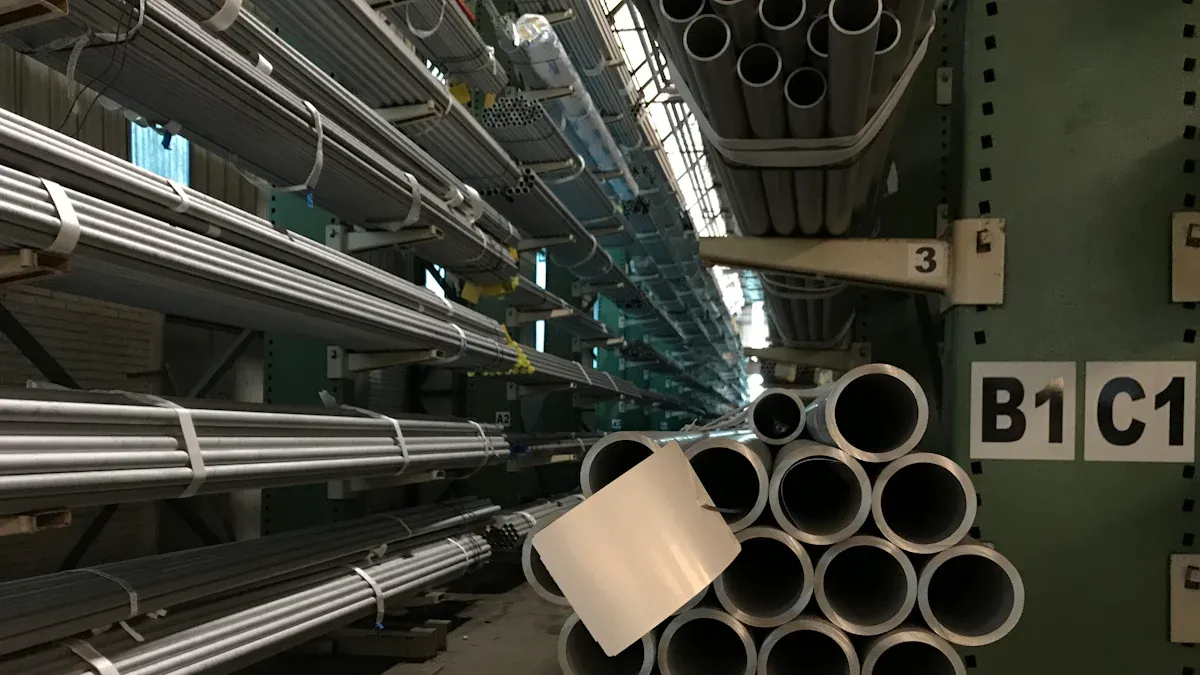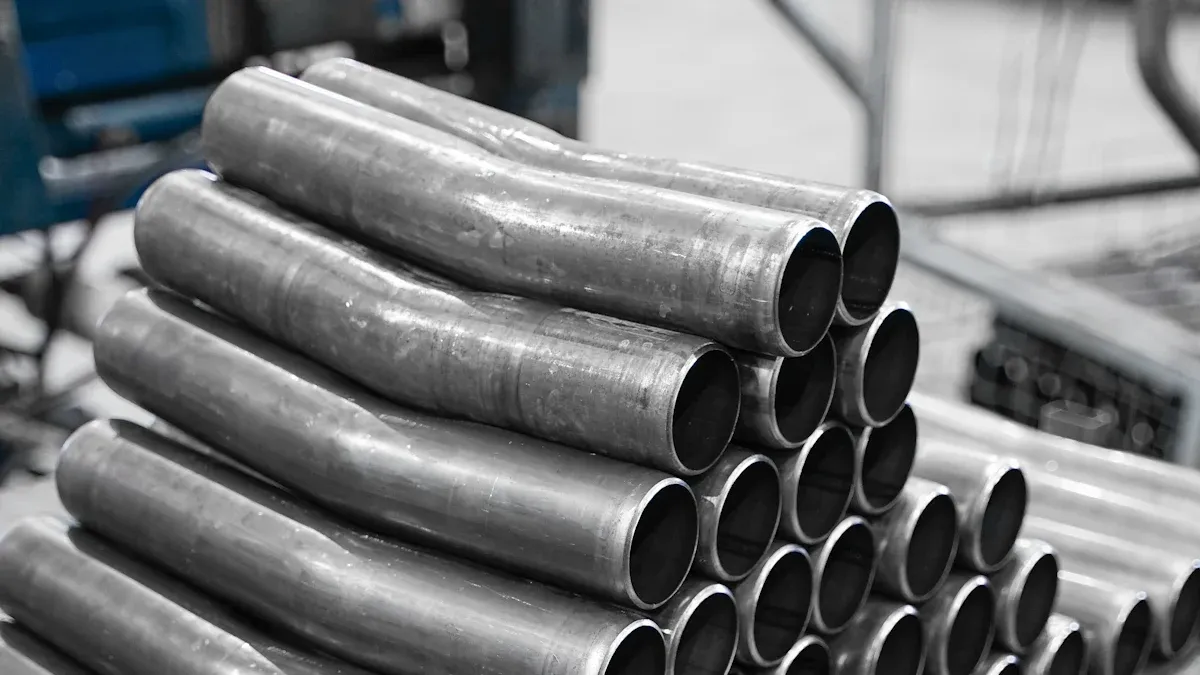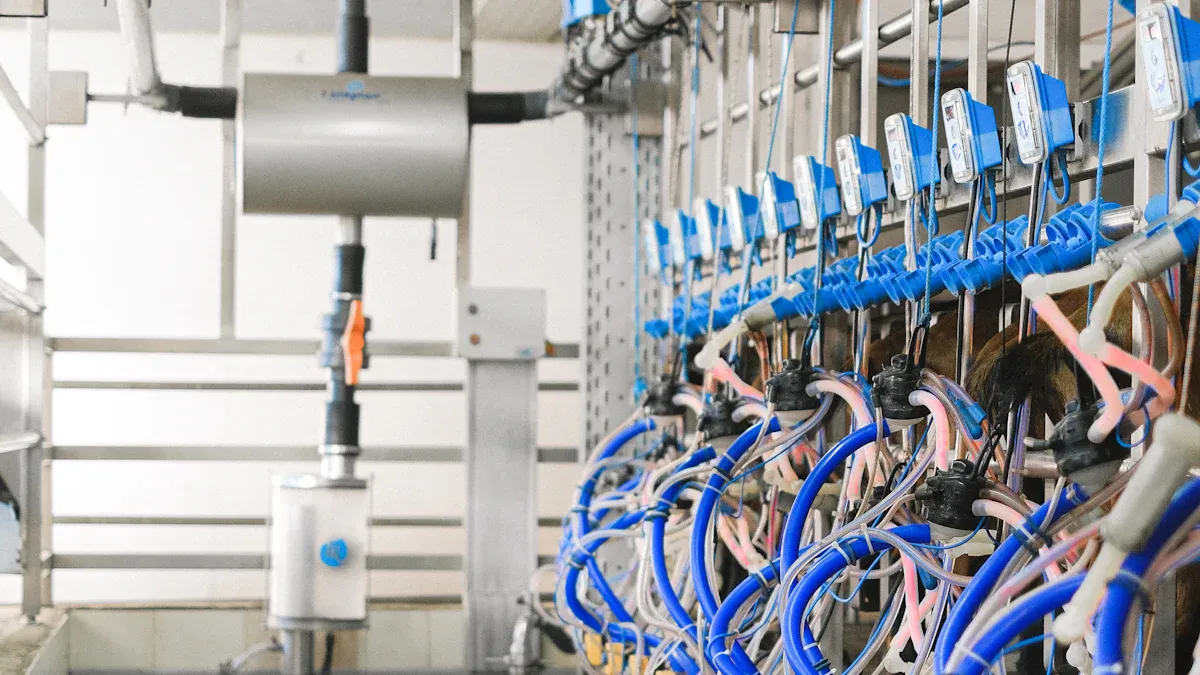How to Select the Best PET Tubing for Precision

Precision plays a vital role in the design of medical device tubing. Accurate dimensions ensure that the tubing performs reliably under demanding conditions. Selecting the right material and design for tubing enhances device functionality and safeguards patient outcomes. Professionals must evaluate factors like material properties, dimensional accuracy, and application compatibility to achieve optimal results. Choosing the best pet tubing for medical device precision minimizes risks and improves the overall performance of medical equipment.
The right tubing can mean the difference between success and failure in critical applications.
Key Takeaways
Pick the right tubing material for good performance and trust.
Focus on size accuracy to fit devices and avoid problems.
Check if it works with cleaning methods to stay safe and strong.
Make sure the supplier is dependable for steady quality and help.
Think about cost and quality to get the best long-term value.
Key Considerations for Medical Device Tubing

Importance of Tubing Material
Selecting the right tubing material is fundamental to ensuring the performance and reliability of medical device tubing. Different tubing materials offer unique properties that cater to specific applications. For instance, silicone is soft and flexible, making it ideal for minimizing dead volume, but it may detach from connectors under stress. Polyethylene provides initial stiffness and a secure fit but can stretch permanently over time. Polyurethane, known for its excellent friction fit, is often recommended for subcutaneous connections due to its durability.
Professionals must evaluate several factors when choosing tubing materials:
Fit: The tubing dimensions must align perfectly with the system to avoid leaks or inefficiencies.
Material Properties: The physical characteristics of the tubing material should match the intended use.
Kink Resistance: Tubing that needs to navigate tight turns must resist kinking to maintain flow integrity.
Compound Compatibility: The material must be compatible with the fluids or compounds it will carry.
Air Permeability: Tubing should prevent air from permeating through its walls, especially in critical applications.
Suitability for Implantation: For implanted devices, the material must be biocompatible and safe for use inside the body.
Cost: The material should meet budget constraints without compromising quality.
The choice of tubing material directly impacts the device's functionality and longevity. Professionals must weigh these factors carefully to ensure optimal performance.
Dimensional Accuracy and Precision
Dimensional accuracy and precision are critical for medical device tubing. Tubing must meet exact specifications to ensure seamless integration with other components. Industry statistics highlight the importance of customization in dimensions and wall thickness, particularly for specialized applications like nerve conduits. Precise dimensions reduce the risk of malfunction and enhance the overall reliability of medical devices.
Manufacturers conduct rigorous material testing to confirm biocompatibility, tensile strength, and wear resistance. These tests ensure that the tubing can withstand the demands of medical environments. Additionally, sterilization validation guarantees that the tubing remains safe for use after exposure to methods like ethylene oxide or gamma rays.
Dimensional accuracy also plays a role in patient safety. Tubing that deviates from specified tolerances can compromise device performance, leading to potential risks. Professionals should prioritize precision during the selection process to maintain high standards of quality and safety.
Compatibility with Medical Applications
PET tubing for medical device precision must meet stringent compatibility requirements to function effectively in diverse medical applications. Its properties make it suitable for demanding environments, ensuring durability and reliability. PET tubing complies with FDA regulations and IEC 60601-1 standards, which certify its safety and effectiveness in medical settings.
The material's resistance to heat, moisture, and chemicals ensures consistent performance over time. PET tubing also withstands harsh chemicals, maintaining its structural integrity and supporting device functionality. Furthermore, it accommodates various sterilization methods, including autoclaving, without losing its essential properties.
Property | Description |
|---|---|
PET heat shrink tubing meets FDA regulations and IEC 60601-1 standards, ensuring safety and effectiveness in medical applications. | |
Durability and Longevity | PET tubing is resistant to degradation from heat, moisture, and chemicals, ensuring consistent performance in demanding environments. |
Chemical Resistance | PET tubing withstands harsh chemicals and maintains integrity, crucial for medical device functionality. |
PET heat shrink tubing endures various sterilization methods, including autoclaving, without losing its properties. |
Professionals must assess the compatibility of tubing materials with operational standards and intended applications. This evaluation ensures that the tubing performs reliably and meets the specific needs of medical devices.
Performance Requirements for PET Tubing

Kink Resistance and Flexibility
Kink resistance is a critical performance metric for PET tubing, especially in medical devices that require precise fluid or gas flow. Tubing must maintain its structural integrity when bent or twisted to prevent blockages or interruptions in flow. PET tubing excels in this area due to its inherent flexibility and resilience. These properties make it suitable for applications where tubing must navigate tight spaces or sharp angles without compromising performance.
The tubing's resilience ensures superior recovery after compression, which is vital for maintaining consistent flow. Additionally, PET tubing demonstrates excellent flexibility at low temperatures, making it reliable in diverse medical environments. Manufacturers often test kink resistance under simulated conditions to validate performance, ensuring the tubing meets stringent medical standards.
Tip: When selecting PET tubing, prioritize products with proven kink resistance to enhance device reliability and patient safety.
Pressure and Vacuum Handling
Medical devices often operate under varying pressure and vacuum conditions, making the tubing's ability to handle these stresses essential. PET tubing is designed to withstand high-pressure environments without rupturing or deforming. This capability ensures the safety and integrity of medical systems, even under demanding conditions.
Manufacturers provide pressure ratings for PET tubing, typically calculated with safety factors such as 3:1 or 4:1. These ratings indicate the maximum pressure the tubing can handle safely. However, additional testing beyond manufacturer recommendations may be necessary to confirm reliability in specific applications. PET tubing's ability to maintain its shape and functionality under vacuum conditions further enhances its suitability for medical devices.
Key considerations for pressure and vacuum handling:
Tubing must resist deformation under high pressure.
Safety factors ensure a margin of reliability.
Vacuum compatibility prevents collapse during suction-based applications.
Temperature Tolerance and Stability
Temperature tolerance is another vital performance requirement for PET tubing in medical devices. The tubing must remain stable and functional across a wide range of temperatures to ensure consistent performance. PET tubing demonstrates exceptional thermal stability, withstanding both extreme cold and high heat without degradation.
Property | Details |
|---|---|
Long-term Temperature | -196°C to 135°C |
Short-term Temperature | Up to 200°C |
Melting Point | 235°C |
These properties make PET tubing ideal for applications involving sterilization or exposure to fluctuating temperatures. Its heat resistance ensures durability during autoclaving, while its low-temperature flexibility supports functionality in cold environments. The tubing's ability to maintain its properties under such conditions enhances its reliability and longevity in medical applications.
Note: Always verify the temperature tolerance of PET tubing to ensure compatibility with your device's operating environment.
Regulatory Compliance and Safety Standards
Biocompatibility and Suitability for Implantation
Biocompatibility is a cornerstone of medical device safety. Tubing used in medical applications must not cause adverse reactions when in contact with human tissues or fluids. PET tubing for medical device precision meets stringent biocompatibility standards, ensuring it performs reliably in sensitive environments. For applications requiring direct contact with the body, suitability for implantation becomes a critical factor. Tubing materials must demonstrate long-term stability and compatibility with biological systems. This ensures that the tubing does not degrade or release harmful substances over time.
Manufacturers often conduct rigorous testing to verify biocompatibility. These tests assess factors like cytotoxicity, sensitization, and irritation. Meeting these standards ensures that PET tubing can be safely used in both external and implantable medical devices. Professionals should always confirm that the tubing complies with ISO 10993 or similar standards to guarantee its suitability for implantation.
Sterilization Methods and Compatibility
Sterility is essential for medical tubing to prevent infections and ensure patient safety. PET tubing offers excellent compatibility with various sterilization methods, making it a versatile choice for medical devices. Common sterilization techniques include autoclaving, ethylene oxide (EtO) exposure, and gamma irradiation. PET tubing retains its structural integrity and performance characteristics even after repeated sterilization cycles.
Each sterilization method has unique requirements. For example, autoclaving subjects tubing to high heat and pressure, while EtO sterilization involves exposure to gas. PET tubing's resistance to heat and chemicals makes it suitable for these processes. Professionals should verify that the tubing's material properties align with the sterilization method used in their application. This ensures that the tubing remains functional and safe throughout its lifecycle.
Tip: Always consult the manufacturer's guidelines to confirm the tubing's compatibility with your chosen sterilization method.
Documentation and Lot Traceability
Comprehensive documentation and lot traceability are vital for maintaining quality and ensuring regulatory compliance. Manufacturers must provide detailed records for each batch of tubing to confirm consistency and reliability. These records include information on production steps, equipment used, and batch identification. Such practices enable professionals to trace any issues back to their source, ensuring accountability and quality control.
Evidence Type | Description |
|---|---|
Performance Qualification (PQ) | Verification that equipment can perform effectively based on approved methods and specifications. |
Process Validation (PV) | Evidence that the process can produce an API meeting predetermined specifications. |
Record Maintenance | Records should include manufacturer details, shipment identity, and supplier information. |
Batch Production Records | Should include complete information on production and control of each batch. |
Documentation of Production Steps | Should include dates, equipment identity, and specific batch identification. |
Professionals should prioritize suppliers who maintain robust documentation practices. This ensures that the tubing meets regulatory standards and provides a clear audit trail for quality assurance.
Practical Tips for Tubing Selection
Balancing Cost and Quality
Cost and quality often compete during the process of choosing tubing. Professionals must strike a balance to ensure the tubing meets performance requirements without exceeding budget constraints. High-quality tubing may come with a higher price tag, but it often delivers better durability, reliability, and compliance with medical standards. On the other hand, opting for low-cost alternatives can lead to compromises in performance, which may increase long-term costs due to failures or replacements.
To make informed decisions, professionals should evaluate the total cost of ownership. This includes not only the initial purchase price but also factors like maintenance, lifespan, and compatibility with sterilization methods. Comparing multiple suppliers and requesting detailed quotes can help identify options that offer the best value for money.
Transparency in Specifications
Clear and transparent specifications play a crucial role in tubing selection. Manufacturers should provide detailed information about the tubing's dimensions, material properties, and performance ratings. This data allows professionals to assess whether the tubing aligns with the specific needs of their medical devices.
For example, specifications should include details on pressure ratings, temperature tolerance, and biocompatibility. These factors ensure the tubing performs reliably under expected conditions. When specifications are vague or incomplete, professionals risk selecting tubing that fails to meet critical requirements. Always prioritize suppliers who offer comprehensive and verifiable documentation.
Tip: Request sample tubing for testing to confirm that the specifications match real-world performance.
Evaluating Supplier Reliability
The reliability of the supplier significantly impacts the success of choosing tubing for medical devices. A dependable supplier ensures consistent quality, timely delivery, and robust customer support. Professionals should research the supplier's reputation, certifications, and track record in the industry.
Key factors to consider include the supplier's adherence to regulatory standards, their ability to provide lot traceability, and their willingness to accommodate custom requirements. Reading customer reviews and seeking recommendations from industry peers can also provide valuable insights. A reliable supplier not only delivers high-quality tubing but also acts as a trusted partner in achieving medical device precision.
Note: Establishing long-term relationships with reputable suppliers can streamline future procurement processes.
Precision remains a cornerstone in selecting PET tubing for medical device precision. It ensures optimal performance, patient safety, and regulatory compliance. Professionals must evaluate critical factors like material properties, dimensional accuracy, and compatibility with medical applications. These considerations directly impact the reliability and longevity of medical devices.
To streamline the selection process, follow these steps:
Choose tubing from reputable manufacturers with robust quality controls.
Verify lot traceability and regulatory documentation.
Confirm compatibility with sterilization methods and temperature ranges.
Assess flexibility, hardness, and pressure-handling capabilities.
Ensure the tubing meets transparency and biocompatibility requirements.
By adhering to these guidelines, professionals can make informed decisions that enhance device functionality and patient outcomes. Selecting the right tubing is not just a technical choice—it is a commitment to excellence in healthcare.
FAQ
What makes PET tubing ideal for medical devices?
PET tubing offers excellent durability, chemical resistance, and biocompatibility. It withstands sterilization methods and extreme temperatures, ensuring reliable performance in medical environments.
How can professionals ensure tubing meets regulatory standards?
Professionals should verify that the tubing complies with ISO 10993 and FDA regulations. Reviewing documentation and lot traceability records ensures adherence to safety and quality standards.
Can PET tubing handle high-pressure applications?
Yes, PET tubing is designed to endure high-pressure conditions without deforming or rupturing. Manufacturers provide pressure ratings to guide its use in specific medical applications.
What factors affect the longevity of PET tubing?
Longevity depends on factors like material quality, exposure to chemicals, and sterilization frequency. Selecting high-grade PET tubing ensures durability and consistent performance over time.
Is PET tubing compatible with all sterilization methods?
PET tubing supports common sterilization methods like autoclaving, ethylene oxide, and gamma irradiation. Professionals should confirm compatibility with the chosen method to maintain tubing integrity.
See Also
A Comprehensive Approach to Selecting Nitinol Tubing
Selecting Ideal Ultra-Thin PET Heat Shrink Tubing for Projects
Finding the Perfect Nitinol Tubing Supplier for You

